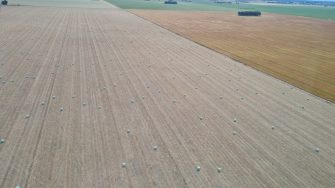
Date: Wednesday, October 27, 2021
Project: Eastern Australian Waterbird Survey
Observers: Richard Kingsford & John Porter
Pilot: James Barkell
After we jumped in the plane at Warrnambool, we headed a little further west, along the coast to Port Fairy, past Tower Hill Reserve wetland, and surveyed a couple more lagoons on survey band 1.
Tower Hill wetland reserve, not on our survey band.
Then it was 200 km flight to the north to the most westerly point on Survey Band 2. Here we started with the saline lakes south of the Coorong and north of Kingston in South Australia.
These lakes sometimes have hundreds of waterbirds but it has been some time since we've seen that. Today there were just a few shelduck, black swans and grey teal.
Then it was surveying Tilley Swamp which is not good waterbird habitat before we got to the really important freshwater wetlands for waterbirds, in between the dunes. It was quite surprising to see how dry it was here, with very few wetlands with water.
Surveying Tilleys Swamp.
One of the dry southeast wetlands in South Australia.
In wet years, there's a string of wonderfully full freshwater wetlands all through here which have large areas of shallow habitat and are great for many species of waterbirds, including most of the duck species. Today, most of the wetland habitat was confined to the drains that run through this area, where there were a few small flocks of teal and black duck.
Today, there was hardly any water, perhaps only about 5% of what we can see in wet years.
This was the first year we had seen pivot irrigation in this part of the world.
As we headed further east, the dry wetlands continued.
Pivot irrigation on the northern part of the Little Desert in Victoria, with interesting colour differences.
We had to check that Lake Hindmarsh, one of the Murray-Darling Basin wetlands that we survey was dry.
The Wetlands around Dimboola on the Wimmera River were all dry.
There were hardly any wetlands with water between the coast of South Australia through to Horsham.
We then set off after lunch from Horsham to the east, surveying wetlands and dams. Quite a few of the dams had water, reflecting what a good season had been experienced down here but strangely none of the large lakes where most of the waterbirds occur, had any water.
Hay bales reflect the good season in this part of the world.
We kept surveying west, picking up some of the rivers, until we were just east of the Wallenjoe wetlands which we had surveyed last week. This completed our surveying of Band 2. We headed north to overnight in Deniliquin.
By Richard Kingsford.
